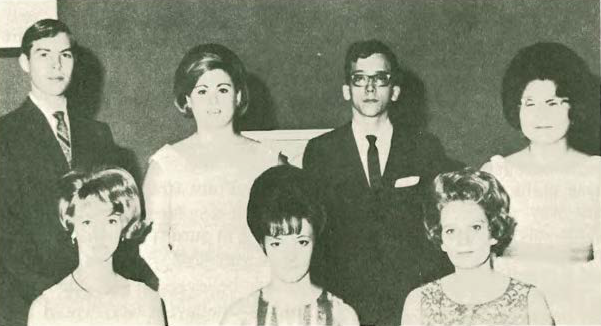
Seven TC students were initiated into Phi Theta Kappa last Thursday in a candlelight ceremony. The ceremony began by forming the insignia.
Maxine Cross, Frank Garyson, Sue Harmon, John Finley, Laura Lampert, Marilyn Ohl, and Nelva Phillips took the oath that placed them into the highest scholastic society of the campus.
Phi Theta Kappa, as described by Tommy Henderson, president, is the Phi Beta Kappa of the junior college. Freshmen must have a 3.6 grade point average and sophomores a 3.4 grade point average to get in.
Tommy introduced the members of PTK, who assisted in the initiation ceremonies. They were David Autrey, vice president; Donna Powell, secretary; Sandra McLeroy, treasurer; Vicki Skelton, historian; and Kathy Counts, reporter; Rita Green, Greta Johnson, Lynn Schooley, Sharon McKinney, Larry Coldiron, Lynda Gibdlson, and Carolyn Kennington. Parents of the initiates and members were present, and attending faculty were Registrar K. B. Davis, Dean Bill Hughes, Mr. and Mrs. Henry Jackson, Mrs. Lois Duck, Mrs. Ruth Fomby, Mrs. Joy Arnold, Miss Gwendolyn Dean, Mrs. Lucille Elgin, Miss Frances Watson, and James Bennett and Mrs. Betty Carter, sponsors of PTK.
Ralph Caver, professor of art at TC and speaker for the occasion, opened with a question for the audience to ponder: “Why does abstract art upset people?” Abstract art upset Khruschev and Hitler. A surprising fact is that abstract art is over 35,000 years old dating back to cave man.
At that time cave man skillfully painted animals on the rocks. Certain symbols, abstract to us, may have been a form of superstition.
Caver continued by saying that in art history the Greeks were the next to rise. Their art was partially abstract in that nature was represented on a flat style. Even as late as the twelfth century, the Gothic artists did not copy nature very well, making their art touch abstraction.
The art instructor said halos and other non-realistic symbols filled illustrations of Pilgram’s Progress and the Book of Revelation, very representative of abstract art. During the same period, Kadensky, who fled Russia, expressed his bold ideas in bright colors to attract attention.
Salvador Dali was one of the forerunners of the “surrealists” followed by Picasso. Picasso, explained Caver, was a very interesting artist. He painted in different schools such as the blue period, a period in which Picasso’s paintings were mostly blue.
No matter how abstract the painting is, to be interesting it must have a center of interest stated the art instructor. For example, a dominant color can be followed around a painting to produce visual tension.
Caver closed by saying abstract art has a place in society today, the evidence being in architecture. Also, abstract art can be appreciated, even though it is not completely understood.
